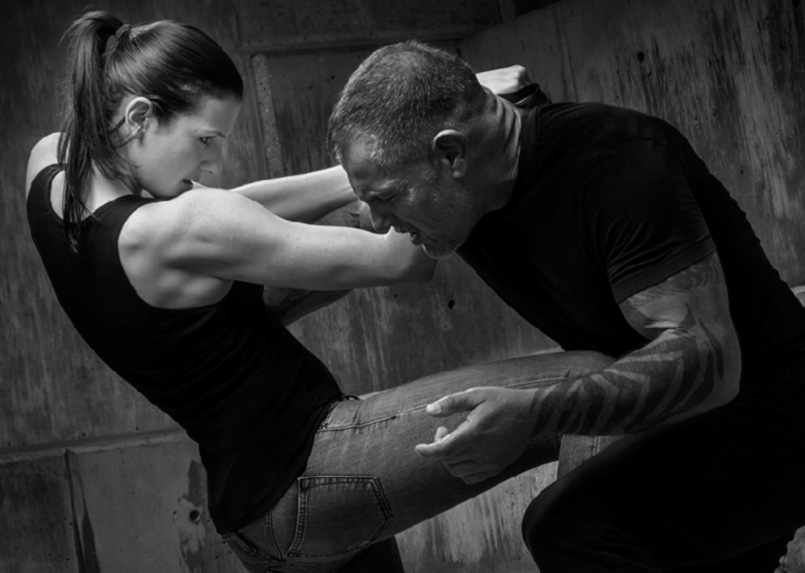
The Ultimate Self-Defence Art For Women
This is a blog post that I feel is a really important one for women.
With the troubling statistics on domestic violence seemingly getting worse and worse, not to mention violent attacks in public, it’s clear that knowing how to defend yourself is becoming increasingly vital.

The ability to defend yourself in an attack can not only save your life, it will instil in you a great sense of self-confidence. It has the ability to transform your mindset from that of a victim to one of strength and empowerment.
In Stronger. Braver. FIGHTER. talk, it will allow you to stop kissing ass and start kicking it.
Let me be quite clear, however.
Getting into a physical altercation or any type of violent confrontation with another individual is highly dangerous. The outcome is always unpredictable. And it should be avoided at all costs.
If, in learning to defend yourself, you become more willing to put yourself into violent situations, you’ve missed the point. Engaging in a fight to defend yourself should only ever be done as very last resort.
Always.
AFTER you’ve tried absolutely everything else. That includes verbal reasoning, leaving the situation, running away if you have to, even begging if that’s what it takes.
If you’re a victim of an ongoing, abusive relationship, all the standard advice regarding getting out of the situation and to safety still applies. Don’t even think about “teaching your partner a lesson” with your new fighting skills, or physically standing up for yourself in a confrontation if you don’t absolutely need to.
That can be terribly dangerous and can actually escalate the situation.
Fight only when there’s absolutely no other way out. Only when you’re given no other alternative, and you’re forced to do so to keep yourself safe and/or alive.
Think of your ability to defend yourself as a safety net, not as a big stick.
Because I’m not an expert in this area, I’ve enlisted some help for this blog post. The following was written by my close friend Fabian, who is the other half of Stronger. Braver. FIGHTER. Fabian began his involvement in the martial arts about 15 years ago and has long been a keen fan of combat arts.
I trust that this post will clarify this often-confusing area for you and arm you with all the facts you need about how to best defend yourself in the case of a physical attack . . .
Learning Self-Defence
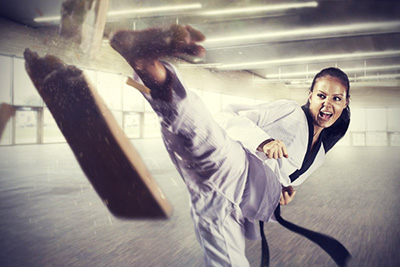
Choosing a martial art for self-defence, or any other purpose for that matter, is by no means as straightforward as it may seem. That’s largely because, as I’ve learned from my own experience, it’s very rare to come across anyone in this area who will offer you unbiased advice.
When I set out searching for an art to study myself for the first time, my experience in pretty much every school I visited was remarkably similar.
When I visited a Wing Chun Kung Fu school, I was told why Wing Chun was the superior form of self-defence. When I visited a Karate school, I was told why Karate was best. Ditto for Jiu Jitsu, other Kung Fu styles, Tae Kwon Do, and so on.
And of course whenever I asked any martial art student for their advice, it just so happened that whatever it was that that individual was studying was the best.
Surely they couldn’t all be right?
No, of course they weren’t.
For the sake of completing the story, I will tell you that I actually went on to study an art called Jeet Kune Do, or JKD. I only stuck with it for about two years however before switching to Muay Thai (Thai Boxing), which I felt was more suited to my tastes and what I was looking for.
One thing I’m very grateful to JKD for though is that it opened my eyes to the benefits of many different arts. That’s because its nature is to “borrow” many techniques from elsewhere. So it really made me very open minded as far as martial arts go.
In this post I’m going to give you my unbiased opinion as to what the best martial art is for a woman seeking the most effective means of personal self-defence, and the best martial art for a woman seeking a combination of fitness and self-defence.
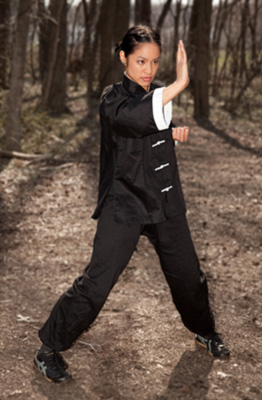
Now, I could just come out and name them both right now, but I’m not going to do that.
That’s because it’s important that you understand why I believe these to be best.
No doubt you’ll come across people in your travels with different views. And chances are, they’ll try to impose those views onto you. Often they’ll sound quite convincing on the surface.
“Oh, but Wing Chun was actually created by a woman to fight off larger male attackers!” they’ll tell you. So what? It still doesn’t mean it works.
Once you’re armed with a good understanding of all the facts, you’ll be better positioned to see through the B.S. and make sound decisions on your own.
The Current State of Martial Arts
I’d like to start with a brief description of where martial arts in general are at today.
The world of martial arts has gone through a tremendous upheaval over past twenty years or so as a result of the growth of the sport of Mixed Martial Arts, or MMA.
In the past, martial arts as a whole were largely clouded in mystery, traditions, and quite frankly, a lot of myths and lies. But once the UFC (Ultimate Fighting Championship) was born in the early 1990s, the smoke and mirrors were pretty much cleared away.
For the first time, different martial arts were able to be put to the test against one another in a realistic arena, and those that were ineffective and impractical in the real world were exposed for what they were.
And the charlatans of the martial arts world were also exposed.
Not that that stopped all of them.
There were two very different reactions from supporters of traditional martial arts to the lessons learned in the UFC.
One group embraced the new knowledge and changed their approach to self-defence and combat to be more realistic and effective. For some it was by modifying and improving their chosen art, or adding to it in some way. But for many it was basically by abandoning what they had learned and starting over from scratch.

The second group, however, chose to bury their heads in sand. They ignored what was happening in front of their very eyes and continued to promote their own art as an effective method of self-defence and combat.
They made up excuses to convince themselves and others that their art was in fact superior to anything else, and that competing in MMA inside a cage was not a valid and realistic means of testing their art’s validity. They would make absurd statements like, “This art is too dangerous to be used inside the cage. You could seriously hurt someone or kill them.”
Whatever.
In any case, these recent developments in the martial arts world have given rise to two major issues for someone interested in choosing a martial art to learn for the first time:
- While martial arts are now far better understood than they once were, there are still a number of schools around promoting martial arts for self-defence that are universally known to be ineffective.
- MMA has reached widespread popularity and appeal as a sport, a form of fitness, and a form of self-defence. For a woman however, in my opinion it isn’t the ideal form of pure self-defence. I’ll explain my reasons shortly.
Categories of Martial Arts
To better understand the various martial arts and their functions, it’s useful to group them into three broad categories:
TRADITIONAL MARTIAL ARTS
Traditional martial arts are those that were developed hundreds of years ago, predominantly in Asia, and passed down through history essentially unchanged. In other words, the traditions and traditional forms of the art are preserved over time, hence the name.
Some examples of traditional martial arts are Karate (various styles), Kung Fu (various styles), Taekwondo, Aikido, Hapkido and Japanese Jiu Jitsu.
The major benefits of learning a traditional martial art are the cultural value and the development of discipline and personal values. They’re therefore great arts to learn from a young age.
SPORTS MARTIAL ARTS
As the name suggests, sports martial arts are those arts that are performed in competition as sports. Some can also sometimes have a traditional aspect to them, however.
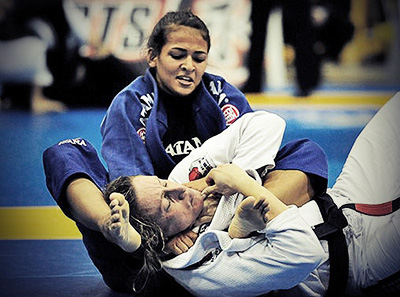
Some examples of sports martial arts are MMA, Muay Thai, boxing, kick boxing, wrestling, Brazilian Jiu Jitsu, Judo and Sambo.
Sports martial arts are great for fitness and many also for self-defence, since they’re usually fine-tuned over time to become more and more effective.
Brazilian Jiu Jitsu, for example, was born out of traditional Japanese Jiu Jitsu many years ago and has undergone constant development and improvement since its inception, to the point where it’s now far superior to its predecessor in terms of effectiveness.
MODERN SELF-DEFENCE MARTIAL ARTS
I’ve made a distinction with “modern” self-defence martial arts since pretty much all traditional martial arts were originally created as forms of self-defence. Fast forward to present day, however, and those arts are more focused on preserving the traditions than on providing the most effective self-defence.
Modern self-defence martial arts were created far more recently and have no such restrictions, making them considerably more effective in the real world.
Some examples of modern self-defence martial arts are Brazilian Jiu Jitsu (different focus to sports Jiu Jitsu), Jeet Kune Do, S.C.A.R.S and Krav Maga.
The 2 Primary Considerations
In learning a martial art for the purposes of defending yourself, there are two very important factors that that art needs to take into consideration.
COMBAT RANGE
The first is what’s known as combat range. Combat Range refers to the range, or distance, at which two combatants are positioned whilst fighting each other. Generally speaking, there are four ranges of combat. These are:
- Kicking Range
- Punching Range
- Clinching Range
- Grappling Range (on the ground)
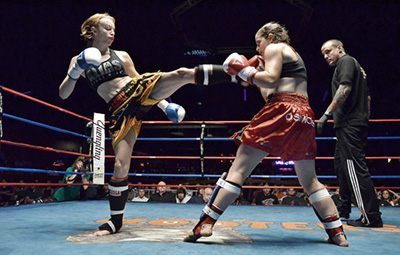
The more ranges of combat in which a martial art can be applied, the more effective that art will be in the real world. As an example, MMA covers all four ranges very effectively. Within any given MMA contest it’s very common to see the two fighters kicking, punching, clinching on their feet, and grappling on the ground.
Some martial arts, however, constrain themselves to just one or two ranges of combat. Wing Chin Kung Fu, for example, specialises in clinching range (although they refer to it as trapping range). This makes the art very ineffective in overall terms.
Imagine a very accomplished boxer, for example, who is suddenly grabbed and clinched by someone, or worse still, tackled to the ground. In situations such as these his or her skills will be almost completely neutralised, and they’ll be totally out of their element.
Individuals sometimes like to delude themselves into believing that they can simply prevent themselves from ever being put into such a situation. A boxer, for example, might believe that if someone attempts to tackle him to the ground, he can simply knock them out with a well-timed punch.
Very wishful thinking.
The reality is that anything can happen at any time. Combat is chaotic and totally unpredictable. Assuming that anything is going to go your way is delusional and inviting disaster. The better prepared you are for any eventuality, the better positioned you’ll be to defend yourself effectively.
UNFAIR ADVANTAGE
The whole objective of learning a martial art in the first place is to give yourself an advantage over a would-be attacker who’s trying to do you harm.
There’s a big problem with that, however.
In the worst-case scenario, where you as a woman are being attacked by a far larger, stronger, male person, he already has an enormous physical advantage over you. So if your goal is to be able to protect yourself, you need to stack the odds in your favour as much as you possibly can to overcome his advantage and gain one of your own.
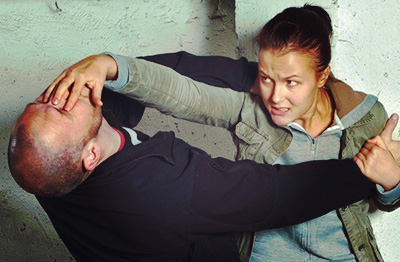
It’s important to understand that self-defence for a male has entirely different considerations to self-defence for a female.
Think about the situations in which the average, everyday male would normally need to defend himself. It will almost always be in a bar-fight or street-fight scenario. In the worst case, it will be against a somewhat larger and stronger attacker. But while this attacker would of course be intent on doing him physical harm, chances are that his intention would not be to kill him.
So for a male, the most useful form of self-defence, one could say, is the ability to take care of himself in a one-on-one fight.
So what about a female?
Well, chances are that as a woman you’re not going to find yourself slugging it out in too many street fights or bar fights with other women.
I think it’s fair to say that most women interested in learning to defend themselves would want to do so to prevent something far more sinister happening to them. And that is, being attacked by a male whose intention is to rape or kill them.
So in other words, the most useful form of self-defence for you as a female is the ability to defend yourself against a life-threatening attack by a much larger, stronger opponent.
Someone with an inherent advantage over you.
That means that you’ll need to be both prepared and skilled at using any and all tactics necessary to save your life. Nothing can be off limits. There can be no rules.
For example, you might need to kick your attacker in the groin as hard as you possibly can, smash a bottle over his head, or jab him in the eyes and permanently blind him.
Sounds gruesome, I know. But we’re talking about your life here.
Remember that.
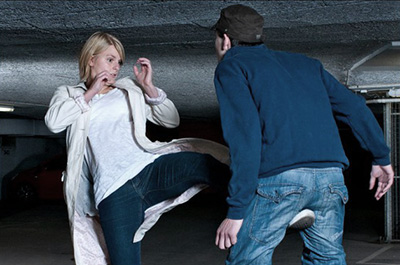
Actions like these would be hard to defend in a court of law for a male involved in a simple bar fight. But for a woman defending her life or saving herself from a potential rapist, they would understandably be far more justified.
Please understand however, I’m not a lawyer and I can’t advise you what would or wouldn’t be allowed under the law. But if saving your life is your primary objective, I think you’ll agree that it makes sense that you need to employ any and every tactic, dirty trick, and cheap shot to gain every advantage you can to survive.
That means you need to train in a martial art that gives you that kind of unfair advantage.
Standing in front of your attacker and trading blows with him might look sexy in the movies, but trust me, it ain’t going to work in the real world.
The Ideal Self-Defence Martial Art
So with an understanding now of exactly what a self-defence scenario is for a woman, we can conclude that the ideal self-defence martial art should involve as many of the following important attributes as possible:
- Specifically aimed at effectiveness in self-defence.
- Not bound by traditions or customs.
- Constantly evolving and improving.
- Covers all 4 combat ranges.
- Has no rules. That is, utilises every dirty, nasty trick and tactic to get an advantage over an attacker.
So, my recommendation for the ideal self-defence martial art for women?
Krav Maga.
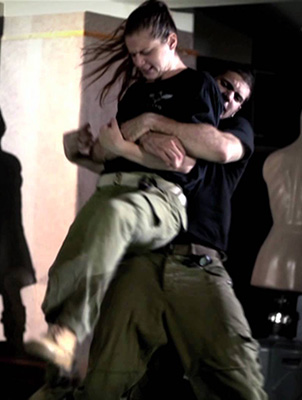
Krav Maga is a martial art that was developed for the Israeli military (IDF) and uses numerous techniques from various martial arts along with realistic fight training. It’s focused on practical, real-world situations and is known for its extreme level of efficiency.
Its philosophy emphasises threat neutralisation, simultaneous defensive and offensive manoeuvres, and lots of aggression.
Over the years Krav Maga has been refined for civilian, police and military applications and has been used mainly by Israeli military, special units, law enforcement, and intelligence organisations, in particular Mossad (the Israeli intelligence agency).
Because of its effective technique, brutality and sheer aggression, it is in my opinion unparalleled as a self-defence art. It can give you the edge, both technically and mentally, in an attack that could save your life.
One important point to note, however, is that Krav Maga is a skill-based art. By training in the discipline you’ll develop those skills but not necessarily your physical attributes to a high degree, since physical fitness isn’t usually a part of the training.
To be able to defend yourself as effectively as possible in any way however, it’s always a good idea to work on developing physical attributes such as strength, conditioning, speed, power, agility, coordination, etc., through an appropriate physical training program.
After all, the stronger you are, the harder and faster you can strike, the fitter you are, etc., the better.
By combining Krav Maga with a good physical training program you’ll maximise your ability to defend yourself from most malicious attacks.
But what if self-defence isn’t your only objective?
What if your goal is to find an art that allows you to develop physically, while at the same time providing the added benefit of teaching you to defend yourself? Many women don’t enjoy exercising simply for the sake of it, and prefer to actually learn something in the process of getting fit.
Fair enough.
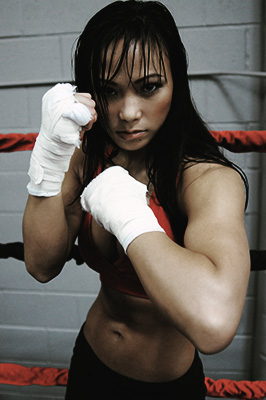
In that case, my recommendation would be Mixed Martial Arts. Because MMA is actually a sport, physical training is part and parcel of learning the art. That means you’re learning to fight and getting into shape at the same time.
Although MMA won’t quite provide you with the same unfair advantage as Krav Maga’s nasty techniques and no-holds-barred neutralising tactics, it will give you a reasonable level of proficiency at fighting in all 4 combat ranges.
It’s important to understand however, that that will only get you so far against a larger, stronger attacker. This is precisely why the sport of MMA includes weight divisions. Size and strength count for a lot.
At the end of the day however, the decision is yours.
You need to first decide what your primary objectives are in learning a martial art, and then make an informed choice as to the best way to meet those objectives.
Hopefully this article has gone some way to helping you do that.








Mary Jones
Posted at 11:12h, 17 MarchHello! I’ve been following your weblog for a long time now
and finally got the courage to go ahead and give you a shout out from Atascocita
Texas! Just wanted to mention keep up the great work!
Gloria
Posted at 18:33h, 18 MarchThanks very much Mary!